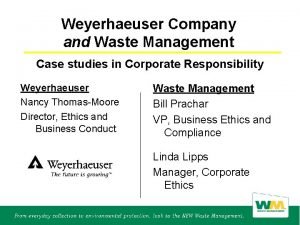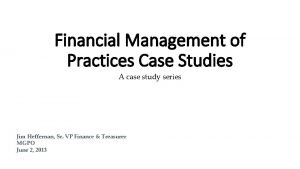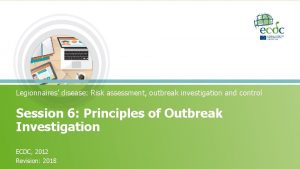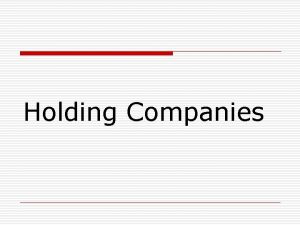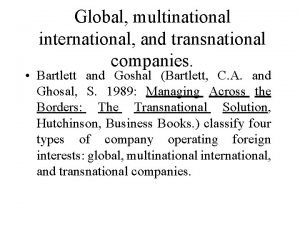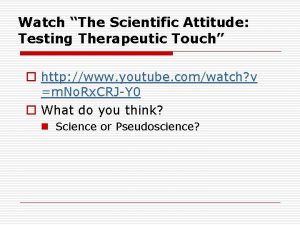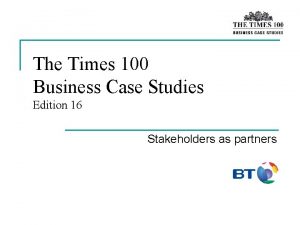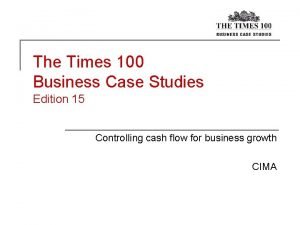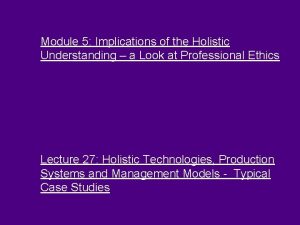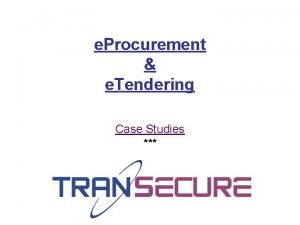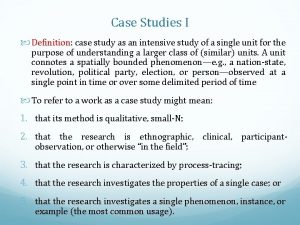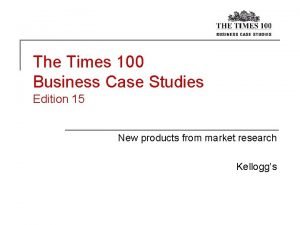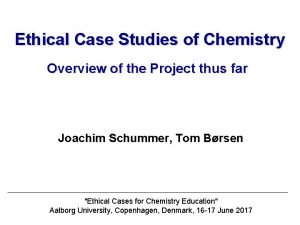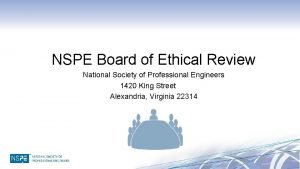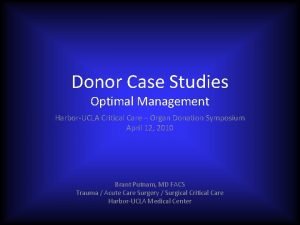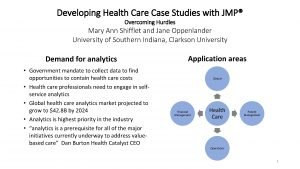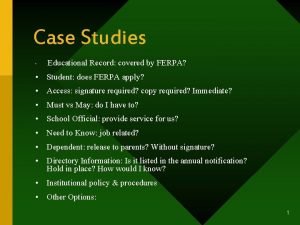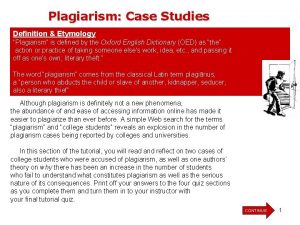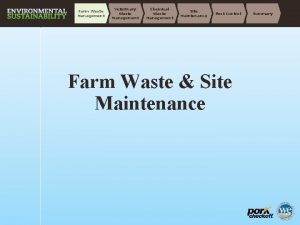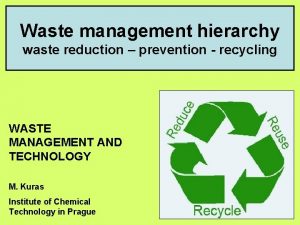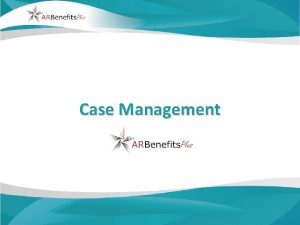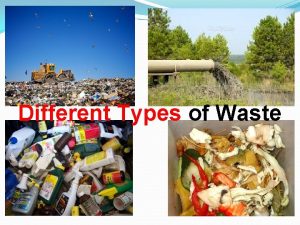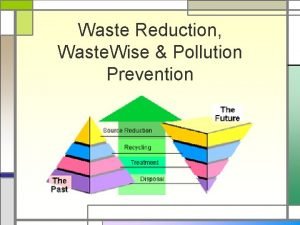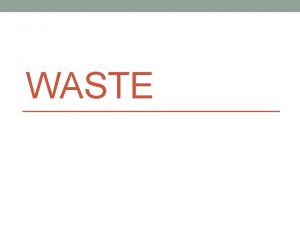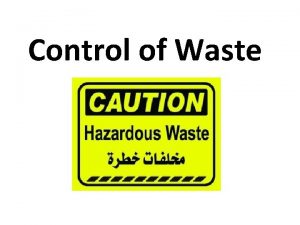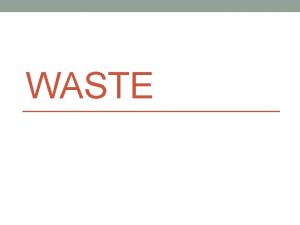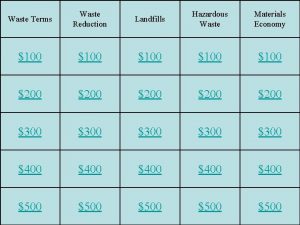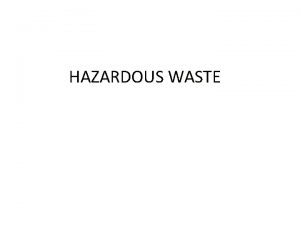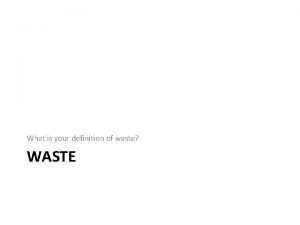Weyerhaeuser Company and Waste Management Case studies in































- Slides: 31

Weyerhaeuser Company and Waste Management Case studies in Corporate Responsibility Weyerhaeuser Nancy Thomas-Moore Director, Ethics and Business Conduct Waste Management Bill Prachar VP, Business Ethics and Compliance Linda Lipps Manager, Corporate Ethics

Before (and after) Sarbanes Or … how we got where we are and where we’re going

Historical Context • The history of business excesses and the public opinion/political/legal response to them is probably as old as “business” itself. • Response to excesses historically relates to: – Legal (civil and criminal sanctions) – Corporate Governance – Compliance standards – Cultural reform (ethics) • Focus today on “modern” (post-1985) developments and trends

Methodology • We’ll look at the drivers that are forcing business organizations to redesign approach to governance, ethics and compliance • How do these apply to privately held businesses • We’ll try to put the questions and responses into historical perspective • We’ll speculate (together) on where we’re going

A time line of key developments • 1980 s - Defense industry procurement irregularities • 1986 - Packard Commission study and recommendations • 1986 - Birth of DII (Defense Industry Initiative on Business Ethics and Compliance) • 1986 - False Claims Act Amendments • 1991 - Organizational Sentencing Guidelines • 1995 - Medicare Fraud • 1990 s - Case law • 2001 - Enron, World. Com, etc. • 2002 – Sarbanes-Oxley

Defense industry procurement irregularities • Ill Wind investigations and other procurement scandals of mid 1980 s highlighted problem • $400 hammer (equal allocation), $2000 toilet seat, $14, 000 coffee maker didn’t help public perception

Packard Commission study and recommendations • In 1985 President Reagan established Blue Ribbon Commission on Defense Management under David Packard • In addition to regulation, the report urged the industry to self-regulate by: – Developing and vigilantly enforcing codes of ethics – The response was the DII

Birth of DII (Defense Industry Initiative on Business Ethics and Compliance) • Jack Welch called the major defense contractors and urged action • 18 contractors met and formed DII • Six basic principles: – – – Codes of Ethics Training Internal reporting of alleged misconduct (Hot Lines) Internal controls and self-reporting (voluntary reporting) Sharing industry best practices Accountability to the public

1986 False Claims Act Amendments • False Claims Act or “Lincoln Law” passed in 1863 to control Civil War profiteers swindling the Union Army • “Qui tam” provisions allow private citizens to sue on behalf of the government – Assessed double damages and $2000 fine for each false claim – “Relator” entitled to 50% of Government’s recovery • Act “weakened” in 1943 • Act amended in 1986 (Grassley & Berman) – Relator gets 15 -30% – Treble damages and $5000 -$10, 000 civil penalty for each false claim

Federal Sentencing Guidelines, a. k. a. Organizational Sentencing Guidelines – Background • U. S. Sentencing Commission established by Sentencing Reform Act of 1984 – Purpose: Eliminate disparity in sentencing by limiting judicial discretion • Guidelines developed first for individuals • Guidelines for organizations became effective 11/1/1991 • DII experience and testimony given great weight

Organizational Sentencing Guidelines – “Carrot and Stick” • Guidelines apply to most Federal crimes committed by corporations • Fine range determined by “point” scale • Up to 95% reduction in fine possible if corporation: – Has “effective compliance program” – Self-reports – Cooperates with Government investigation – Accepts Responsibility

Organizational Sentencing Guidelines - 7 Basic Elements of an “Effective Compliance Program” l l Standards & Procedures. An organization must have established compliance standards and procedures “that are reasonably capable of reducing the prospect of criminal conduct. ” High-Level Oversight. One or more senior corporate officials must have been assigned “overall responsibility to oversee compliance. ” Care in Delegating Authority. Due care required to avoid delegating substantial discretionary authority to persons the organization knew, or should have known, “had a propensity to engage in illegal activities. ” Education and Training. Must “communicate effectively” standards and procedures to all employees and agents through training programs and “practical” publications.

Organizational Sentencing Guidelines - 7 Basic Elements of an “Effective Compliance Program” l l l Auditing, Monitoring & Reporting Systems. Must take reasonable steps to achieve compliance with standards by utilizing monitoring and auditing systems reasonably designed to detect criminal conduct and have in place and publicize an employee reporting system to report criminal conduct without fear of retribution. Consistent Enforcement. Standards must be consistently enforced through appropriate disciplinary mechanisms. Appropriate Response. After issues detected organization must take reasonable steps to respond appropriately and take such steps as necessary, including program modifications, to prevent similar offenses.

Organizational Sentencing Guidelines “Effective Compliance Program” – Other Factors • Sophistication of program will depend on: – Size of Organization. The larger the organization, the more program formality is required. – Nature of Business. The likelihood that certain offenses may occur due to the nature of the organization’s business means that special care must be taken to prevent those types of offenses. – Prior history of organization. Recurrence of misconduct “casts doubt on whether it took all reasonable steps to prevent such misconduct. ”

Organizational Sentencing Guidelines “Effective Compliance Program” • Justice Department Charging Guidelines (Holder Memorandum) say there are two critical factors in determining effectiveness: – “…whether the program is adequately designed for maximum effectiveness in preventing and detecting wrongdoing. ” – “…whether corporate management is enforcing the program or is tacitly encouraging or pressuring employees to engage in misconduct to achieve business objectives. ”




In re Caremark • Delaware Chancery case • Strong dictum regarding advisability of Boards adopting and overseeing implementation of Sentencing Guidelines compliant “effective compliance programs” • Chancellor Allen wrote: "Any rational person attempting in good faith to meet an organizational governance responsibility would be bound to take into account this development [the adoption of the Organizational Sentencing guidelines] and the enhanced penalties and the opportunities for reduced sanctions that it offers. " He continued: "The Guidelines offer powerful incentives for corporations today to have in place compliance programs to detect violations of law, to promptly report violations to appropriate public officials when discovered, and to take prompt, voluntary remedial efforts. "

Other Compliance Program Drivers • Case Law – Faragher v. City of Boca Raton and Burlington Industries, Inc. v. Ellerth. U. S. Supreme Court rules that in certain circumstances an effective compliance program can act as an affirmative defense to hostile environment sexual harassment claims. • Policy Trends – EPA policy provides, in some circumstances, for reduced civil penalties and no criminal sanctions when corporation has effective environmental compliance program. • Medicare Fraud – HHS adopts several model compliance plans following sentencing guidelines model.

Enron, World. Com, etc. • So what’s this all mean for all of us involved in law, regulation, compliance governance? – Congressional, SEC, Stock Exchange response – Challenges facing corporate lawyers and compliance officers – Clues of the rest of us.

Some areas of tension • “Hot Lines” as a tool to uncover illegal, unethical, or policy violating acts. – Not a privileged communication – Must investigate all issues • Voluntary disclosure • Self examination privilege? ? ? • “To dig or not to dig? ”, that is the question.



Waste Management A Case Study The Ethics Revolution in The American Workplace By Linda Lipps

WM History • “Old” Waste – 1970 s Wall Street ‘darling’ • Merger – 03 -98 the unthinkable happens • Improper accounting tactics – SEC begins investigation • “New” Waste Management – 11 -98

Problems At The Door • Waste Management had lost the trust of its customers, employees and investors. • The company’s information systems could not get accurate bills out to its customers. • Customers were leaving to the competitors. • Employee morale was sinking faster than the Titanic. • The stock price was sinking along with it.

“Great companies are admired for their products, services, and integrity. We want to be a great company. ” Maury Myers • Company had excellent physical assets. • Hard working people who were willing to listen. • And about $1 billion in free cash flow.

What Was Necessary? • A Clear Set of Core Values. -Honesty -Respect -Responsibility -Citizenship -Environmental Stewardship -Excellence • Effective Leadership. • Communication.

Program Framework Video Posters Integrity Help Line Code of Conduct Training CEO Updates/ Town Hall Meetings

In Conclusion….
 Revenue generation plan
Revenue generation plan Waste management company profile doc
Waste management company profile doc Best case worst case average case
Best case worst case average case Financial management case study
Financial management case study Paradigm shift from women studies to gender studies
Paradigm shift from women studies to gender studies Advantages and disadvantages of case control studies
Advantages and disadvantages of case control studies Case series
Case series Subsidiary company meaning
Subsidiary company meaning Multinational vs transnational corporations
Multinational vs transnational corporations Ciria
Ciria Advantages of descriptive research
Advantages of descriptive research Times 100 case studies
Times 100 case studies The times 100 business case studies
The times 100 business case studies Holistic technology in human values
Holistic technology in human values Gdpr case studies
Gdpr case studies Gcse geography manchester case study
Gcse geography manchester case study Case studies on euthanasia
Case studies on euthanasia E procurement case studies
E procurement case studies Types of case studies
Types of case studies Definition of case study
Definition of case study Kellogg's crunchy nut bites market research
Kellogg's crunchy nut bites market research Nasa system failure case studies
Nasa system failure case studies Abo discrepancy case studies with answers
Abo discrepancy case studies with answers Chemistry ethics case studies
Chemistry ethics case studies Nspe code of ethics
Nspe code of ethics Goal2u
Goal2u Jmp case studies
Jmp case studies Case studies of rtos
Case studies of rtos Ferpa case studies
Ferpa case studies Social engineering case studies
Social engineering case studies Plagiarism etymology
Plagiarism etymology Digital marketing case studies 2012
Digital marketing case studies 2012

